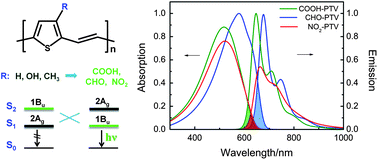Theoretical design of polythienylenevinylene derivatives for improvements of light-emitting and photovoltaic performances†
Abstract
Poly(thienylene

- This article is part of the themed collection: Organic optoelectronic materials
* Corresponding authors
a
Key Laboratory of Organic OptoElectronics and Molecular Engineering, Department of Chemistry, Tsinghua University, Beijing, China
E-mail:
zgshuai@tsinghua.edu.cn
Fax: +86-10-62525573
Tel: +86-10-62797689
b
Key Laboratory of Organic Solids, Beijing National Laboratory for Molecular Science (BNLMS), Institute of Chemistry, Chinese Academy of Sciences, Beijing, China
E-mail:
qpeng@iccas.ac.cn
Fax: +86-10-62525573
Tel: +86-10-82616830
c Department of Applied Chemistry, National Chiao Tung University, Hsinchu, Taiwan
Poly(thienylene

 Please wait while we load your content...
Something went wrong. Try again?
Please wait while we load your content...
Something went wrong. Try again?
Y. Jiang, Q. Peng, X. Gao, Z. Shuai, Y. Niu and S. H. Lin, J. Mater. Chem., 2012, 22, 4491 DOI: 10.1039/C1JM14956C
To request permission to reproduce material from this article, please go to the Copyright Clearance Center request page.
If you are an author contributing to an RSC publication, you do not need to request permission provided correct acknowledgement is given.
If you are the author of this article, you do not need to request permission to reproduce figures and diagrams provided correct acknowledgement is given. If you want to reproduce the whole article in a third-party publication (excluding your thesis/dissertation for which permission is not required) please go to the Copyright Clearance Center request page.
Read more about how to correctly acknowledge RSC content.
 Fetching data from CrossRef.
Fetching data from CrossRef.
This may take some time to load.
Loading related content
